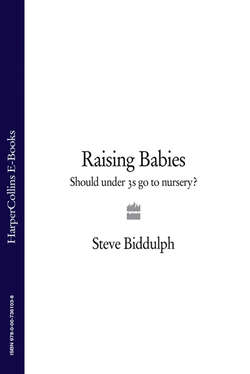Читать книгу Raising Babies: Should under 3s go to nursery? - Steve Biddulph, Steve Biddulph - Страница 33
What do you prefer?
ОглавлениеDr Catherine Hakim, a researcher at the London School of Economics, has attracted worldwide attention for some new thinking about the whole question of mothers and paid work.4 Hakim came to the enlightened realization that all of the statistics about childcare that one ever reads were based on what people were doing. But what if they instead asked people what they would prefer to do? Asking this question revealed a completely different picture. Up until that point, governments had made a sweeping assumption – all mothers (and fathers) want to work, and like doing so. In a way, this was as stereotyped as the 1950s idea that all mothers liked staying at home and cooking scones. When people were interviewed about their actual preferences, Hakim found three distinct groups:
1 Home-centred women who give priority to children and family life, and prefer not to do paid work at all. This group makes up about 20 per cent of women in the UK. (And probably of men too, if they were given the choice.)
2 Work-centred women who give priority to careers. Again, this group makes up about 20 per cent.
3 Adaptive women who combine work and family life, but saw work as being something to fit around their family life, rather than the reverse. This group makes up about 60 per cent.
(The focus solely on work and family can be limiting here: most women are also involved in activism, education, and other pursuits that define their lives more broadly than these two specific roles. SB)
Hakim argued that by basing policies on the work-centred 20 per cent, just because they conformed to certain feminist expectations, the home-centred group were disadvantaged, as were the adaptive women, who often preferred shorter hours and other reforms that made it possible to meet the needs of children. This argument had huge implications for governments – for instance, the funds and tax breaks poured into subsidizing nursery care might be better spent on subsidizing those parents who wanted shorter working hours, or simply wish to stay at home and care for their children – and could do so more cheaply and better than nurseries could manage.
Hakim’s work has strong statistical support, and has galvanized discussion, since it allows for more diversity of choice, and is patently more realistic. It also brought to the fore some of the real tensions current in our lives. For instance, at one time it was male managers who did not understand the needs of women in the workforce. Staff I worked with recently at a large university told me a sad story of how the women on the academic staff had eagerly awaited a woman vice-chancellor, who would understand their needs for maternity leave, leave to care for sick children and flexible work hours, only to find that the woman who got the job was far more judgemental and less compassionate than her male predecessor. Their situation went into reverse, and 20 years of gradual gains were wiped out in a year.
Many magazines and press articles have described the ‘Mummy Wars’, in which fierce divisions exist between stay-at-home mothers and mothers in the paid workforce. It’s likely that both groups secretly envy some of the options enjoyed by the other. Hakim’s research would suggest that a large proportion of us would like the benefits of a timely return to work, but not at the expense of our children. It doesn’t seem too hard for employers and governments to meet this reasonable demand. If we also add an availability of fathers to do their part in the early years, then the problem is not insurmountable.
For a young couple contemplating starting a family, or with a new baby at home, it is important to do some hard thinking. We human beings are easily confused, and very much herd creatures. We do what everyone else does. We accept platitudes that really don’t make sense, but sound good. We are told ‘what’s good for you is good for them’. Also our own background has a big effect. If we don’t have a strong experience of parental love in our own childhood, we might not know what we are losing.
There is intense and intelligent discussion going on in the UK today about these choices. Parents in the past have often been fobbed off with bland reassurance, as if parenthood somehow softens the brain, but we are now more educated, more questioning and more networked than ever. And, fortunately, the answers are now emerging to address our concerns. In the following chapters, we will look at this in depth. The big question in choosing between slamming, sliding or staying at home, is: what is best from a child’s point of view?
